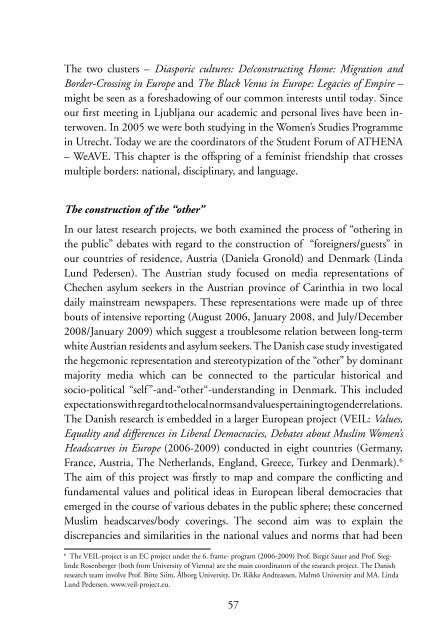Teaching with the third wave new feminists - MailChimp
Teaching with the third wave new feminists - MailChimp
Teaching with the third wave new feminists - MailChimp
You also want an ePaper? Increase the reach of your titles
YUMPU automatically turns print PDFs into web optimized ePapers that Google loves.
The two clusters – Diasporic cultures: De/constructing Home: Migration andBorder-Crossing in Europe and The Black Venus in Europe: Legacies of Empire –might be seen as a foreshadowing of our common interests until today. Sinceour first meeting in Ljubljana our academic and personal lives have been interwoven.In 2005 we were both studying in <strong>the</strong> Women’s Studies Programmein Utrecht. Today we are <strong>the</strong> coordinators of <strong>the</strong> Student Forum of ATHENA– WeAVE. This chapter is <strong>the</strong> offspring of a feminist friendship that crossesmultiple borders: national, disciplinary, and language.The construction of <strong>the</strong> “o<strong>the</strong>r”In our latest research projects, we both examined <strong>the</strong> process of “o<strong>the</strong>ring in<strong>the</strong> public” debates <strong>with</strong> regard to <strong>the</strong> construction of “foreigners/guests” inour countries of residence, Austria (Daniela Gronold) and Denmark (LindaLund Pedersen). The Austrian study focused on media representations ofChechen asylum seekers in <strong>the</strong> Austrian province of Carinthia in two localdaily mainstream <strong>new</strong>spapers. These representations were made up of threebouts of intensive reporting (August 2006, January 2008, and July/ December2008/January 2009) which suggest a troublesome relation between long-termwhite Austrian residents and asylum seekers. The Danish case study investigated<strong>the</strong> hegemonic representation and stereotypization of <strong>the</strong> “o<strong>the</strong>r” by dominantmajority media which can be connected to <strong>the</strong> particular historical andsocio-political “self”-and-“o<strong>the</strong>r“-understanding in Denmark. This includedexpectations <strong>with</strong> regard to <strong>the</strong> local norms and values pertaining to gender relations.The Danish research is embedded in a larger European project (VEIL: Values,Equality and differences in Liberal Democracies, Debates about Muslim Women’sHeadscarves in Europe (2006-2009) conducted in eight countries (Germany,France, Austria, The Ne<strong>the</strong>rlands, England, Greece, Turkey and Denmark). 6The aim of this project was firstly to map and compare <strong>the</strong> conflicting andfundamental values and political ideas in European liberal democracies thatemerged in <strong>the</strong> course of various debates in <strong>the</strong> public sphere; <strong>the</strong>se concernedMuslim headscarves/body coverings. The second aim was to explain <strong>the</strong>discrepancies and similarities in <strong>the</strong> national values and norms that had been6The VEIL-project is an EC project under <strong>the</strong> 6. frame- program (2006-2009) Prof. Birgit Sauer and Prof. SieglindeRosenberger (both from University of Vienna) are <strong>the</strong> main coordinators of <strong>the</strong> research project. The Danishresearch team involve Prof. Birte Siim, Ålborg University, Dr. Rikke Andreassen, Malmö University and MA. LindaLund Pedersen. www.veil-project.eu.57
















